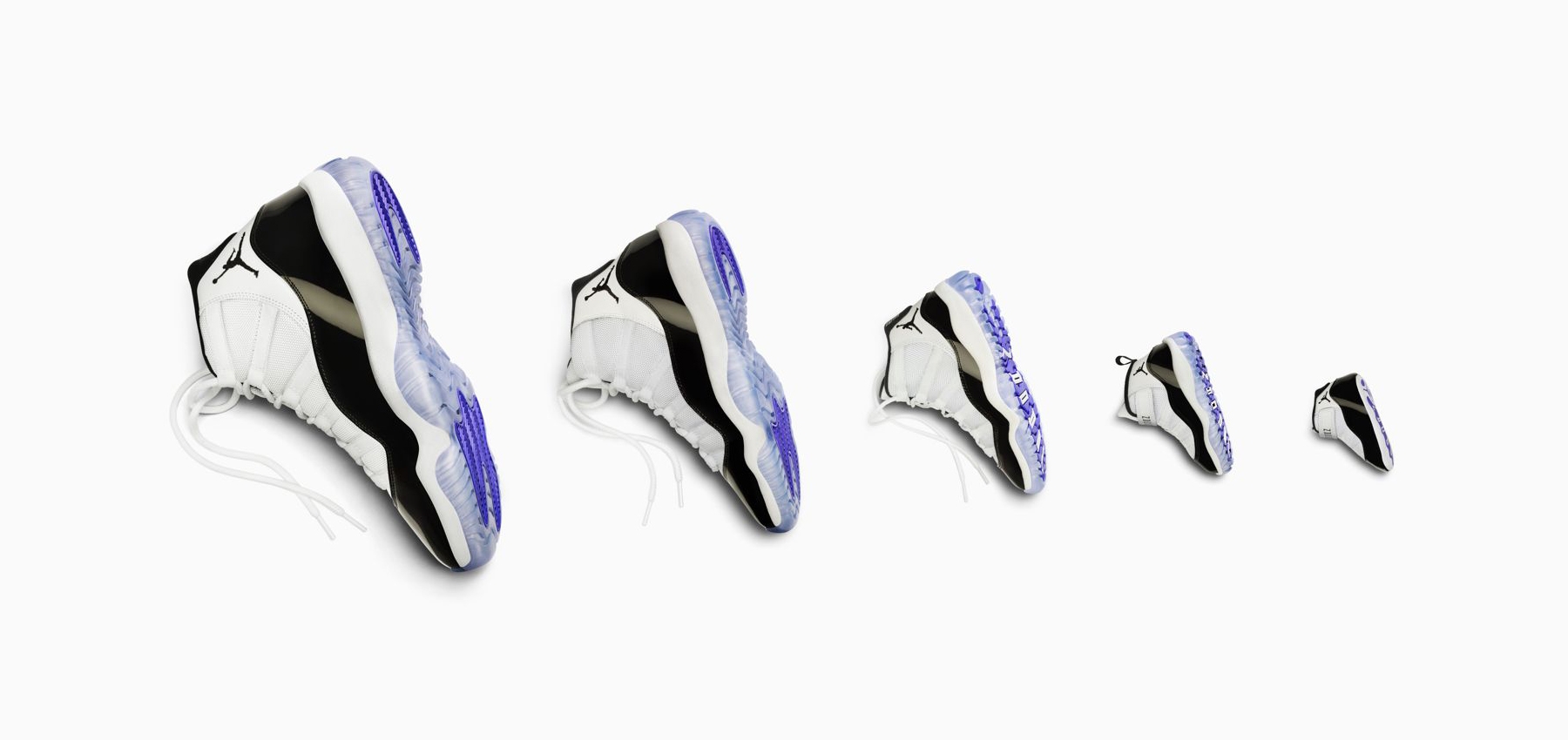The drop
When Nike launched its Air Jordan XI “Concord,” in 2011, there were incidents of violence reported at several shopping malls in the US.
Back then, most shoe stores sold pairs on a first-come, first-served basis, which led to physical fights between people who were trying to line up outside their local shop. A lot has changed.
Over the past few years, sportswear giants like Nike and Adidas have turned to technology to make sneaker shopping safer, particularly for highly coveted models. And there’s no better example of this digital-first strategy than the drop of the long-awaited 2018 edition of the Concord XIs, which re-released on December 8th without any chaos, thanks in large part to mobile apps like Nike’s SNKRS.

If Nike and Adidas can’t stop services like AIO Bot and RSVP Kingz on their own, the real solution could be federal regulation, the kind that would outlaw the use of automated systems in online shopping for good. In 2016, President Barack Obama signed the Better Online Ticket Sales (BOTS) Act into law, making it illegal for individuals to use bots (or other computer software) to buy tickets to concerts, sporting events and other entertainment events at venues of over 200 people with the intention to sell them. Congress also made it an offense to knowingly buy an event ticket from someone who used a bot.
According to the BOTS Act, it is a violation of the law to “circumvent a security measure, access control system, or other technological control or measure on an internet website or online service that is used by the ticket issuer to enforce posted event ticket purchasing limits or to maintain the integrity of posted online ticket purchasing order rules.” Of course, implementing similar guidelines across the web would be complex, but the Bots Act set a precedent that the government isn’t a fan of auto-shopping tools.
New York senator Chuck Schumer, who helped introduce the original BOTS bill in 2016, did not answer to multiple requests for comment. But last December he urged retailers to find ways to eliminate bots. “Grinch bots cannot be allowed to steal Christmas, or dollars, from the wallets of New Yorkers,” he said. “Middle-class folks save up — a little here, a little there — working to afford the hottest gifts of the season for their kids, but ever-changing technology and its challenges are making that very difficult. It’s time we help restore an even playing field by blocking the bots.”
“Grinch bots cannot be allowed to steal Christmas, or dollars, from the wallets of New Yorkers.”
For sneakerheads, the Grinch seems to strike year-round. And when Air Jordans or Adidas Yeezys that were originally priced at $160–$200 can sell for thousands of dollars, you can see where the disconnect between customers and brands happens. That’s why some of them end up relying on services like AIO Bot or RSVP Kingz, or give up altogether and end up having to pay a premium on resale sites like StockX.
“Our biggest challenge,” said Adidas’ global SVP of digital, Scott Zalaznik, “is creating experiences that reward the consumer with the products they love while also recognizing the hunt and scarcity of the product.” He said the mission for Adidas is “to combat the bulk purchasing of high-demand items for the purposes of reselling,” but at the same time the company can’t lose focus on “connecting” more with the consumer and improving the user experience on its site and apps.
In general, he said, the digital aspect that’s now touching sneaker culture “is making and will continue to make the process safer” for everyone involved. “The image of consumers queueing for long hours and physical lines outside stores as a reference of success,” he said, “is not accurate anymore.”
Don’t confuse the fact that the launch went smoothly with lack of demand, however: The men’s version of the shoe sold out in minutes everywhere, from Nike’s own SNKRS app to online sites including Champs Sports, Finish Line and Foot Locker. These are the same retailers that used to deal with mayhem on every release of limited-edition Air Jordans at their brick-and-mortar locations. But they, too, are now relying on apps to create reservation-based systems that make the entire buying process less hectic and, most important, safer for consumers. The only risk people take now, if they can’t order a pair online and have it shipped to their home, is getting robbed outside a store. But that’s more a problem with humanity than with the brands or retailers themselves.
Technology is something the industry desperately needed, and these efforts by companies like Nike are validated when brick-and-mortar launches go wrong and have to be canceled because of issues with crowd control. This was the case recently, during the release of the SoleFly Air Jordan I, an exclusive collaboration between Nike and a Miami boutique that was scheduled to drop at Art Basel Miami Beach. The launch was scrapped after people jumped over metal barricades trying to get into the venue. Eventually, days later, SoleFly ended up tweeting a link to a Google Form where people could enter their personal information to enter a raffle and hopefully win a pair of its Jordans.
The situation in Miami was yet another example of how, in order for shoe drops to be safe, online launches are the way to go. “Whereas a few years ago every other week we were seeing fights outside of retail stores, lately those [violent] instances have been few and far between,” said Joe La Puma, SVP of Content Strategy at Complex and host of the video series Sneaker Shopping. He said that stores and brands “who are successful in the sneaker business” are smart enough to know that the space clearly needed a change, and they’re the ones that see digital releases as a solution to the problem. “People’s safety,” he said, “is the biggest concern for everyone.”
While the safety-first formula may have been solved, going almost exclusively digital to sell hyped sneakers presents a new challenge for brands and retailers: bots, automated computer scripts that can purchase items faster than a human can. Traditionally, since drops began happening online, bots came with the stigma that they were being used only by resellers. For someone who makes a living reselling sneakers, bots are the ideal tool to scoop as much inventory as possible from online sites.
The All in One Bot (aka AIO Bot) software, for instance, costs $399 and works for Mac and PC. When users buy the AIO Bot, they program it by entering personal details, like shipping/billing address and credit card info, to get it ready for an online launch on Nike.com, FinishLine.com or FootLocker.com, to mention a few sites. Then, on release date, as soon as the sale goes live, the AIO Bot monitors these sites and can automatically buy whatever product you’ve pointed to within seconds. And in the sneaker game, every second counts. More often than not, by the time people without a bot finish entering their info on a checkout page, the item they wanted has sold out.
Brands and retailers have tried to combat bots by developing “virtual walls” for their sites, designed to spot suspicious activity during a release and let people enter product pages at random. Those systems are intended to scan for non-human-like behavior, which would be something like an automated script that’s constantly refreshing a page or entering checkout info in milliseconds. That doesn’t always stop the bots, but it’s not for lack of effort.
“The very premise of sneaker culture is the hustle. As times change, the hustle will continue to change.”
It’s a cat-and-mouse game between brands/retailers and software developers like AIY Solutions, the creator of the AIO Bot, which also makes other brand-specific products, including Another Nike Bot and Supreme Bot. “I’ve seen 18-year-olds go from having nothing to being able to make $100K-plus in a single release,” said Alex Kabbara, CEO at AIO Bot. “And even the smaller users [are] buying their first car, or getting an extremely hyped shoe they wanted, thanks to our software.” Kabbara wouldn’t specify exactly how many customers the AIO Bot has, but he said that number is in the “thousands.”
Naturally, for people who just want a pair to wear, not resell, bots are viewed as a toxic part of sneaker culture. But Kabbara disagrees. “The very premise of sneaker culture is the hustle,” he said. “As times change, the hustle will continue to change. Today it’s bots, so get on board! If you can’t beat them, join them.” Kabbara added that, even if there weren’t any bots to worry about, sneakerheads would be saying that the brands are ruining the space by making shoes limited in the first place. “Sneaker culture is this,” he said. “It’s about being limited, about hype and clout!”
Those who don’t have money to pay for the AIO Bot or similar software have to rely on other methods to try to get the sneakers they want online — like using auto-fill extensions for web browsers. But those are now being blocked by some brands and retailers, too, since they’re considered to give people an advantage over average shoppers. Nowadays, you can’t be be sure the item you just bought from Nike, Adidas, FinishLine or Supreme is yours until you get a shipping confirmation. If your order goes through but the brand’s system detects bot or activity from an auto-fill browser extension, chances are it’ll be canceled.
Kabbara said that brands and retailers are doing “an amazing job,” so much so that they’re making the “100 or so new bots that come out every year” obsolete within months because of the lack of success. “We’ve had to invest [in] a lot of tech to make sure our customers have the best chance possible, and that’s why we’ve been here for over four years,” he said. “These methods mean nothing to us and are easily worked around.”

AIO Bot not only is an expensive investment, but it also requires a bit of technical know-how. That includes things like being able to set up proxy servers to ensure you can place multiple orders on different websites simultaneously without your IP address getting blocked.
Thankfully for sneakerheads and streetwear enthusiasts, there are other bot-based services that are much easier to use.
RSVP Kingz was created by a 14-year-old, just before he went to high school. Now a 20-year-old college student, the founder asked for anonymity, and is identified by the pseudonym “John” in this article. John’s company offers an auto-checkout service that gives users the ability to secure limited-edition shoes or apparel online without having to do any of the legwork. Here’s how RSVP Kingz works: On a particular launch date for an Air Jordan or Adidas Yeezy, you order a “slot” from them for the item you would like to purchase, which can range anywhere from $30 to a few hundred dollars, depending on the scarcity of the shoe. That service fee is on top of the retail price for the sneaker, but John said RSVP Kingz always aims to make users pay less for a pair than they would on the resale market.
Once you’ve paid for your slot on the RSVP Kingz site, you then have to fill out a form with all your personal information, including name, shipping and billing address as well as credit card number. These details, which John said are encrypted and not shared for any other purpose than the purchase, are used because RSVP Kingz essentially just takes care of the transaction — its only job is to buy the shoes for you, so the company never comes in contact with the product.
This is akin to how the AIO Bot works, but with RSVP Kingz you don’t have to worry about anything on release date. If it succeeds, you’ll just get an email from the brand or retailer itself, notifying you that they received your order. And if it doesn’t, you get whatever fee you paid for the slot returned to you.
John said he came up with the idea for RSVP Kingz after experiencing difficulties of his own to get the shoes he wanted. “I realized there [had to be] an easier way to automate the process,” he said, noting that as of 2018 RSVP Kingz can have anywhere from a couple hundred to a couple thousand customers per drop. The success rate depends on a number of variables, John said, but he added that it is “a known fact within the industry that we have the most success among auto-checkout services.” You can see proof of this on the RSVP Kingz Twitter account, which has nearly 33,000 followers and, on any given launch date, will retweet people who thank it for helping them get the Jordans or Yeezys they were after.
“If a million people are chasing 1,000 pairs, there are going to be 999,000 people who are upset.”
The biggest challenge for RSVP Kingz, John said, is constantly having to adapt to the anti-bot efforts from brands and retailers. “It’s a big hurdle, but we have a team of developers that is dedicated solely to that,” he said. “We’re always able to update and adjust, and that’s why we’re known to be so successful.”
John said his message to the brands is that, regardless of what they think about his service, it’s not hurting them. “If a million people are chasing 1,000 pairs, there are going to be 999,000 people who are upset, who don’t get the pairs.” he said. “Even without any bots or any advantages had by anyone, the level of unhappiness and unsuccessful customers would remain the same for the brands.” John said his company is, in essence, providing the same goal as the brands, which is for customers to have the product they want. He said that what differentiates RSVP Kingz from software like the AIO Bot that is often used by resellers, is that his customers aren’t ending up with “10, 15 or 20 pairs.”

Mobile apps play a major role in companies’ e-commerce business, and Nike and Adidas are investing heavily in the space. Many of Nike’s most coveted drops are now happening on its SNKRS app, where it uses technologies like augmented reality to let people buy shoes. The company first started experimenting with the medium in 2017, during the release of its SB Dunk High Pro “Momofuku,” a sneaker designed in collaboration with famous chef David Chang, which users could purchase only by using an AR feature.
To unlock these in the SNKRS app, users had to go to the product page, tap on a 3D model of the sneaker and then point their smartphone’s camera at a menu of Chang’s Fuku restaurant in New York City. Alternatively, customers could also gain access by pointing their device at a picture of the menu or special SNKRS posters that Nike put up around NYC.
Perhaps most important, since AR in SNKRS requires constant physical interaction between the user and the app, it could be the perfect way to mitigate the bots issue. Nike’s president of direct-to-consumer business, Heidi O’Neill, said at a media conference last year that the SNKRS augmented reality feature “has come very close to eliminating bots, and taking the sneaker hunt [to] as close to a fair game that I think it is anywhere in the industry,” but she didn’t dive into any specifics. “We don’t want to disappoint,” she said. “While it’s a game, we don’t want our members and people who love the brand and love sneakers to feel like they’ve lost.”
In an interview last November, Nike Chief Digital Officer Adam Sussman told Engadget that the company didn’t create these features with auto-buying tools in mind — though he considered the fact that AR could mitigate the issue a welcome by-product. “We’re very focused on security and stability. Every time we have a release, we’re incredibly focused on limiting any type of bot attacks,” he said. “But we’re also moving to a world of serving consumers one to one, [and] that naturally fights off bot attacks, because now we’re starting to develop individual relationships.”
Nike isn’t the only one who sees an opportunity in AR. Adidas, too, has recently started using AR to sell limited-edition sneakers. The feature made its debut at ComplexCon in California this past November, where it let attendees buy a collection of hyped sneakers by pointing their smartphone at different physical beacons inside the venue. The company also used AR to let people “try on” its next flagship running shoe, the UltraBoost 19, on Snapchat — similar to what Nike did prior to the launch of the 2018 Jordan Concord XIs.
La Puma, whose Complex show Sneaker Shopping is one of the most watched on YouTube, said that “what people have to understand is these brands thrive” on figuring out the next big thing for consumers. “We used to go into the store and pick shoes off the shelf,” he said, “and now we have to deal with codes that are being written for bots.” Aside from augmented reality, he pointed to Nike’s surprise drops on SNKRS as another great example of how these companies are evolving and trying different things. “What the brands are trying to do is fight [bots] as much as possible,” he said. “And not even fight but, really, innovate. You’re never gonna make everyone happy, but [they] are looking at this as a very big priority in terms of user experience and how customers are purchasing.”
Meanwhile, Kabbara, the CEO of AIO Bot, said those augmented reality features have “just been a gimmick so far” to get brands “to jump on the VR/AR train.” He said, results-wise, the tech has “had no effect at all” against bots.
(33)


